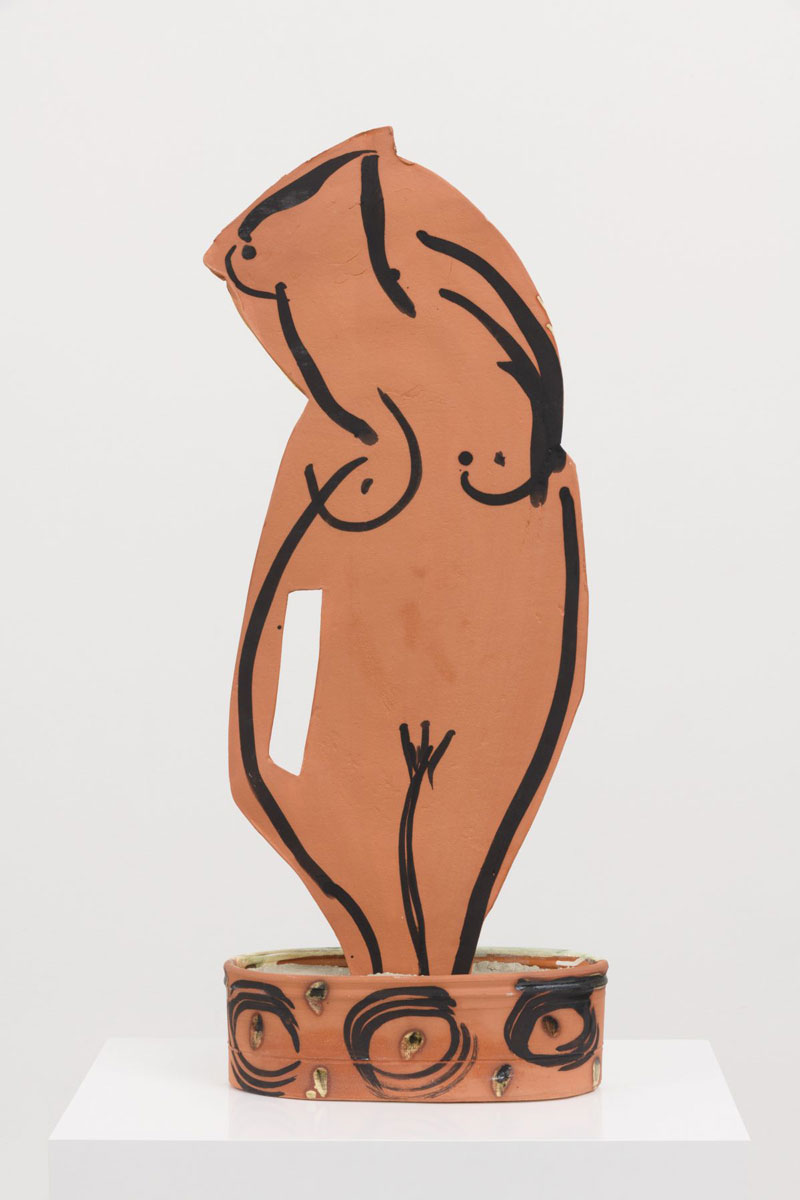No conversation about the history of ceramics in art, especially about works created by female artists, would be complete without mention of Betty Woodman. The artist, who recently passed at age 87, shifted the conventions of ceramics—that of functional objects to be used in the home—and lifted the medium beyond the scope of its interior confines. At the beginning of Woodman’s career, ceramics was in a limbo space between art and artisan and was dominated mostly by men. Today, ceramics has been folded into the norm of acceptable mediums and Woodman is aptly considered a cornerstone of the medium.
Her solo show at David Kordansky Gallery builds on themes that she explored throughout her career, and offers an experimental study and celebration of the female form and interior spaces through ceramics, paint and other mixed media. The scenes created in the works are relatable and unpretentious—visions of vases, bedrooms, a kitchen, lattice fencing, plates and kitchenware, interior walls and carpets. The confines of simple home and interior motifs give Woodman boundaries to push up against and experiment with. Through novel uses of the medium, she extends earthenware from its usual forms; she takes the idea of what a vase is and abstracts it.
Woodman keeps the organic nature of the materials intact, even throughout her various experimentations. By keeping edges rounded and imperfect, it gives the impression that Woodman is not trying to conquer the materials but rather is shaping them. The paint looks distinctly like paint, the earthenware like earthenware, especially in the parts that are unglazed.
The exhibition could be broken up into two types of works—ones that lend themselves to be viewed more like paintings, and ones that appear more like sculptures. The sculptures are technically pitchers and vases, yet upon first glance would not appear as such. They shift and morph as the viewer walks around them, and in some cases, such as His and Hers Vases: Life Drawing (2018), appear completely different whether viewed from the front or the back.
One of the first things noticeable upon entering the space is the jubilant use of color. Woodman uses an unapologetic amount of pink, a color that is typically associated with hyper-femininity and seems to do so in a completely unironic way. The works also feature a barrage of patterns, all of which are lifted from distinct inspiration. The checkerboard tablecloth in Summer Tea Party (2015–16) is a nostalgic throwback to domestic kitsch, while the background hints at Japanese-textile work with its cherry blossom print. Other textile-inspired motifs are thrown in the mix, with the floral pattern in Lady and Leaning Vase (2011) and again in Tuesday Afternoon (2016). Woodman uses color and patterns to create space, rather than shading and light, as in Lady and Leaning Vase (2011). By splitting the background up into color blocks, she creates the illusion of walls, floor and object. In some instances, the work has a sense of cut-out paper and creates an illusion of collage.
Woodman plays with the appearance of foreground and background by having elements outside of the 2D picture plane, either by affixing ceramic pieces directly onto the canvas alongside the painting, or by having clay on the floor in front of the canvas as in Bedroom with Lattice (2009) and Tuesday Afternoon (2016). This choice to play with the picture plane and use 3D materials alongside paintings to create a cohesive piece is extremely trendy right now, and yet these works do not seem to be following a trend. This is evident not only in the 2D/3D commingling but also in the variety of forms that Woodman molds the material into. In The Front Hall (2014), broken pieces of ceramics create a giant leaning vase, which overcomes many ceramicists’ worst nightmare—that of creating a work and then having it break at the last minute.
A thread present in many of the works is that of playing with the motif of equating women’s bodies with objects through sometimes suggestive and other times more obvious. Equating women’s bodies with objects has a long history in art, yet Woodman’s work lacks the misogynistic trappings typically associated with such an idea, perhaps because she is a woman, and perhaps because the works are a celebration of forms, both material and human.



